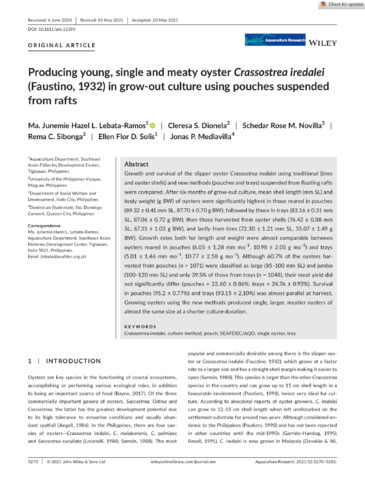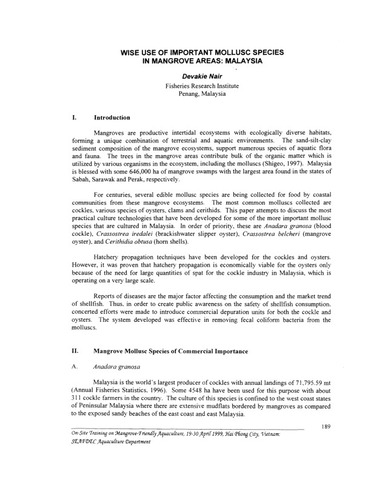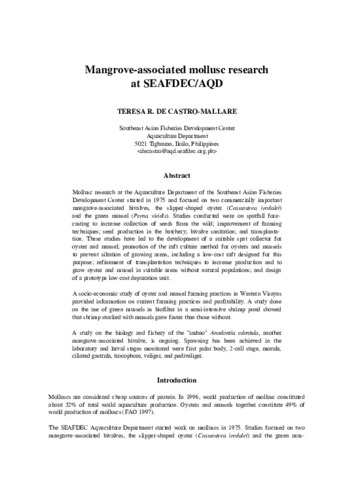Producing young, single and meaty oyster Crassostrea iredalei (Faustino, 1932) in grow‐out culture using pouches suspended from rafts

Quan điểm/
Request this document
Ngày
2021-06-11Tác giả
Page views
279metadata
Hiển thị bản ghi đầy đủ mặt hàngCited times in Scopus
Share
trừu tượng
Growth and survival of the slipper oyster Crassostrea iredalei using traditional (tires and oyster shells) and new methods (pouches and trays) suspended from floating rafts were compared. After six months of grow-out culture, mean shell length (mm SL) and body weight (g BW) of oysters were significantly highest in those reared in pouches (89.32 ± 0.41 mm SL, 87.70 ± 0.70 g BW), followed by those in trays (83.16 ± 0.31 mm SL, 87.06 ± 0.72 g BW), then those harvested from oyster shells (76.42 ± 0.88 mm SL, 67.35 ± 1.03 g BW), and lastly from tires (72.30 ± 1.21 mm SL, 55.07 ± 1.49 g BW). Growth rates both for length and weight were almost comparable between oysters reared in pouches (6.05 ± 1.28 mm mo−1, 10.98 ± 2.05 g mo−1) and trays (5.01 ± 1.46 mm mo−1, 10.77 ± 2.58 g mo−1). Although 60.7% of the oysters harvested from pouches (n = 1071) were classified as large (85–100 mm SL) and jumbo (100–120 mm SL) and only 39.5% of those from trays (n = 1048), their meat yield did not significantly differ (pouches = 22.60 ± 0.86%; trays = 24.76 ± 0.93%). Survival in pouches (95.2 ± 0.77%) and trays (93.15 ± 2.10%) was almost parallel at harvest. Growing oysters using the new methods produced single, larger, meatier oysters of almost the same size at a shorter culture duration.
Suggested Citation
Lebata-Ramos, M. J. H., Dionela, C. S., Novilla, S. R. M., Sibonga, R., Solis, E. F., & Mediavilla, J. P. (2021). Producing young, single and meaty oyster Crassostrea iredalei (Faustino, 1932) in grow‐out culture using pouches suspended from rafts. Aquaculture Research , 52(11), 5270-5282. https://doi.org/10.1111/are.15395
Chủ thể
oyster culture  ; spat
; spat  ; aquaculture
; aquaculture  ; growth
; growth  ; oysters
; oysters  ; survival
; survival  ; shells
; shells  ; body weight
; body weight  ; length
; length  ; Crassostrea iredalei
; Crassostrea iredalei  ; Culture method; Pouch; Single oyster; Tray
; Culture method; Pouch; Single oyster; Tray 
 ; spat
; spat  ; aquaculture
; aquaculture  ; growth
; growth  ; oysters
; oysters  ; survival
; survival  ; shells
; shells  ; body weight
; body weight  ; length
; length  ; Crassostrea iredalei
; Crassostrea iredalei  ; Culture method; Pouch; Single oyster; Tray
; Culture method; Pouch; Single oyster; Tray 
Taxonomic term
Bộ sưu tập
- AQD Journal Articles [1215]
Related items
Showing items related by title, author, creator and subject.
-
Wise use of important mollusc species in mangrove areas: Malaysia
Nair, Devakie (Aquaculture Department, Southeast Asian Fisheries Development Center, 2000)For centuries, several edible mollusc species are being collected for food by coastal communities from these mangrove ecosystems. The most common molluscs collected are cockles, various species of oysters, clams and ... -
Molluscan aquaculture in the Philippines: A review
Lebata-Ramos, Ma. Junemie Hazel (Springer, 2023-04-25)Molluscs are among the most valuable resources of the Philippines, an archipelagic country of 7,107 islands bounded by 36,000 km of coastline and 26.6 million ha of coastal waters. In 2020, production from mussels and ... -
Mangrove-associated mollusc research at SEAFDEC/AQD
De Castro-Mallare, Teresa R. (Aquaculture Department, Southeast Asian Fisheries Development Center, 2000)Mollusc research at the Aquaculture Department of the Southeast Asian Fisheries Development Center started in 1975 and focused on two commercially important mangrove-associated bivalves, the slipper-shaped oyster (Crassostrea ...




